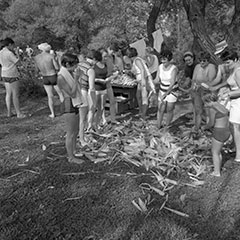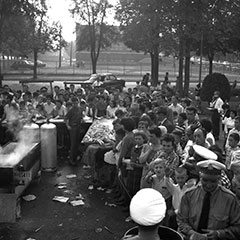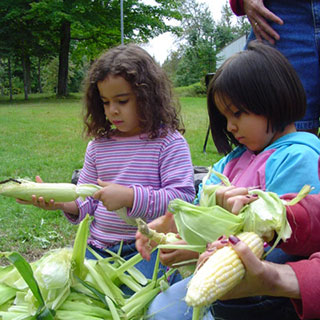The Corn Roast
The importance of corn farming in Québec, like everywhere else in Canada, is such that it led to the corn roast tradition, or husking bee, which takes place at the end of harvest. In the past, it was a crucial chore, meant to garner and conserve corn. Farmers gathered their family, friends, and neighbours to shuck corn provisions for the winter. Songs and jokes made the job more pleasant. The roast was generally followed by a meal and dancing party, with plenty to drink. This festive spirit remains today, even if the notion of chore does not exist anymore.
In Québec, the evening began by peeling the ears of corn, called Indian corn in the province, piled high in the centre of the room. Until the 1950s, the corn roast took place in the barn. It then migrated to the kitchen, often considered the main room in a farmhouse. Among laughter and exclamations, the corn was boiled, roasted, or braised. The grains were shucked by rubbing two corncobs together or with a metal blade. The leaves were kept and braided.
Corn roasts were great occasions for social or romantic encounters. Each “husker” dreamed of finding the red corncob, because this “love corn” granted whoever found it the right to kiss the person of his or her choice. It was also believed the red corn brought good luck and kept its owner from misfortune.
La chanson de l’épluchette (literally The Corn Roast Song), published in the songbook titled La gaieté canadienne : 40 autres chansons d’autrefois (Canadian Joyfulness: 40 Other Songs From the Past) by Conrad Gauthier, is among the traditional songs linked to this task.
We organized a bee
And all our good friends
In their big carriage
Came to the husking bee
Ah! The delicious corn
Delicious corn on the cob
Ah! The delicious corn
Delicious boiled corn
Girls and boys
All have nice ways about them
Finding a red corncob
Will allow them to kiss each other
But before we eat it
It needs to be “wet”
To whet one’s appetite
Hurrah for country customs
L’épluchette (The Corn Roast)
Download audio (3 minutes 21 seconds, 3.07 MB )
A duet (man and woman) singing L’épluchette accompanied by violin and piano.
Composer: Albert Larrieu
Harmonisation: Van de Goor
Performers: Albert Viau and Simone Quesnel Y, 1941
Source: BAnQ – Digital collection [sound recordings]
A real man from here, laïrou
I went all alone
To my corn roast duty, laïrette
Him: I noticed you a lot
In Rivière-du-Loup
There was no brunette
As cute, as elegant as you.
When the red ear will be out
The one who loves you will kiss you.
Go quickly to the corn roast, roast
And you will find
A nice handsome husband who will love you
Now and forever.
To become a woman
Nice little Canadian girl
Oh! Just look around
And you will find
A nice guy
From Canada, oh yes!
Her: We piled in front of us
A lot of red corn, laïrou
And we chat
On the old spruce bench, laïrette
Him: I loved you and kept hoping
I thought I would be
The happiest man on earth
If you became my girlfriend.
When the red ear will be out
The one who loves you will kiss you.
Go quickly to the corn roast, roast
And you will find
A nice handsome husband who will love you
Now and forever.
To become a woman
Nice little Canadian girl
Oh! Just look around
And you will find
A nice guy
From Canada, oh yes!
Him: While looking everywhere
I suddenly found, laïrou
An ear, my dear Annette
Cherry red, laïrette
Her: You then stood up
And kissed me on the head
Showing in that moment to everyone
The cute soft red ear.
When the red ear will be out
The one who loves you will kiss you.
Go quickly to the corn roast, roast
And you will find
A nice handsome husband who will love you
Now and forever.
To become a woman
Nice little Canadian girl
Oh! Just look around
And you will find
A nice guy
From Canada, oh yes!
Skamonkas, the Corn Moon
Maize is of great importance in Native American cultures. Here is a Wabanakis legend on corn.
Among the thirteen moons of the Wabanakis nation’s calendar, Skamonkas, the September moon, is that of the corn. Wabanakis worshipped this plant as a precious gift from their First Mother. As legend has it, she gave her life to keep her children from succumbing to starvation, when hunting no longer sufficed to feed a growing population. First Mother died and her body was reborn in the shape of corn and tobacco plants. She taught them to keep the grains of corn to sow them again, ensuring they would never run out of food again. As for tobacco, it was used to support prayer as its smoke rose to the heavens.





